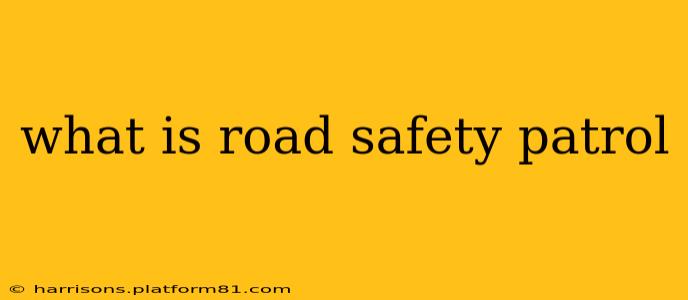Road Safety Patrols (RSP) are student-led volunteer programs found primarily in schools across North America. They're dedicated to improving safety for students and the wider school community, particularly around roadways and pedestrian crossings. While the specifics might vary slightly between schools and regions, the core mission remains consistent: promoting safe pedestrian and cyclist behavior and ensuring students get to and from school safely.
What are the responsibilities of a Road Safety Patrol?
RSP members take on a range of responsibilities, all centered around promoting safety. Their tasks often include:
- Controlling pedestrian crossings: This is a primary function, involving guiding students across streets and ensuring they obey traffic signals. They typically use signage, hand signals, and sometimes stop signs to manage pedestrian traffic.
- Enforcing school rules: RSP members help maintain order and safety within the school vicinity, particularly around bus stops, entrances, and parking areas.
- Educating fellow students: Beyond direct supervision, they play a vital role in educating their peers about safe pedestrian and traffic practices. This might involve posters, announcements, or classroom talks.
- Reporting hazards: RSP members are trained to identify and report any potential hazards, like damaged sidewalks, poor visibility, or reckless driving near the school. This helps the school administration address safety concerns proactively.
- Promoting awareness: They often participate in community safety events and campaigns, extending their reach beyond the school walls.
Who are the members of a Road Safety Patrol?
Road Safety Patrols are typically made up of older, responsible students, often from the upper elementary or middle school grades. They are selected based on their maturity, reliability, and commitment to safety. Thorough training is provided before they begin their duties.
How do Road Safety Patrols get trained?
Training is a crucial aspect of RSP programs. It usually covers:
- Traffic laws and regulations: Students learn the basics of road safety, including pedestrian right-of-way, traffic signals, and safe crossing techniques.
- Safe patrol procedures: They are taught how to effectively control pedestrian crossings, use signaling equipment, and communicate with drivers and students.
- Emergency procedures: Training includes what to do in case of accidents or emergencies. This might involve contacting emergency services or administering basic first aid.
- Communication skills: Effective communication is essential for this role, so training focuses on clear and confident interaction with others.
What are the benefits of a Road Safety Patrol?
The benefits of Road Safety Patrols are numerous, extending to students, schools, and the wider community:
- Increased student safety: The most significant benefit is a demonstrable reduction in accidents and injuries near the school.
- Improved community relations: RSPs foster positive relationships between the school and the local community by actively promoting safety.
- Development of leadership skills: Participating in the RSP program provides students with valuable leadership experience and responsibility.
- Enhanced sense of responsibility: It instills a sense of civic duty and community involvement in young people.
- Improved traffic flow: By managing pedestrian crossings effectively, RSPs can help improve traffic flow around the school.
How can I start a Road Safety Patrol?
If you're interested in starting an RSP at your school, it’s crucial to collaborate with school administration, local law enforcement, and potentially your municipality's traffic department. They can provide guidance, training resources, and potentially even equipment. A successful RSP program requires planning, resources, and consistent support from all stakeholders.
What equipment does a Road Safety Patrol typically use?
Depending on the resources available, RSPs might utilize various pieces of equipment, including:
- Stop signs or flashing lights: To control traffic and clearly signal to drivers that students are crossing.
- High-visibility vests or jackets: To ensure patrol members are easily visible to drivers and other students.
- Handheld stop signs: For directing pedestrian traffic across crossings.
- Whistles: To gain attention and provide clear signals.
This comprehensive overview should provide a clear understanding of Road Safety Patrols and their essential role in ensuring the safety of students and the community. Remember, local variations may exist, so always check with your local school or authorities for specific details.
